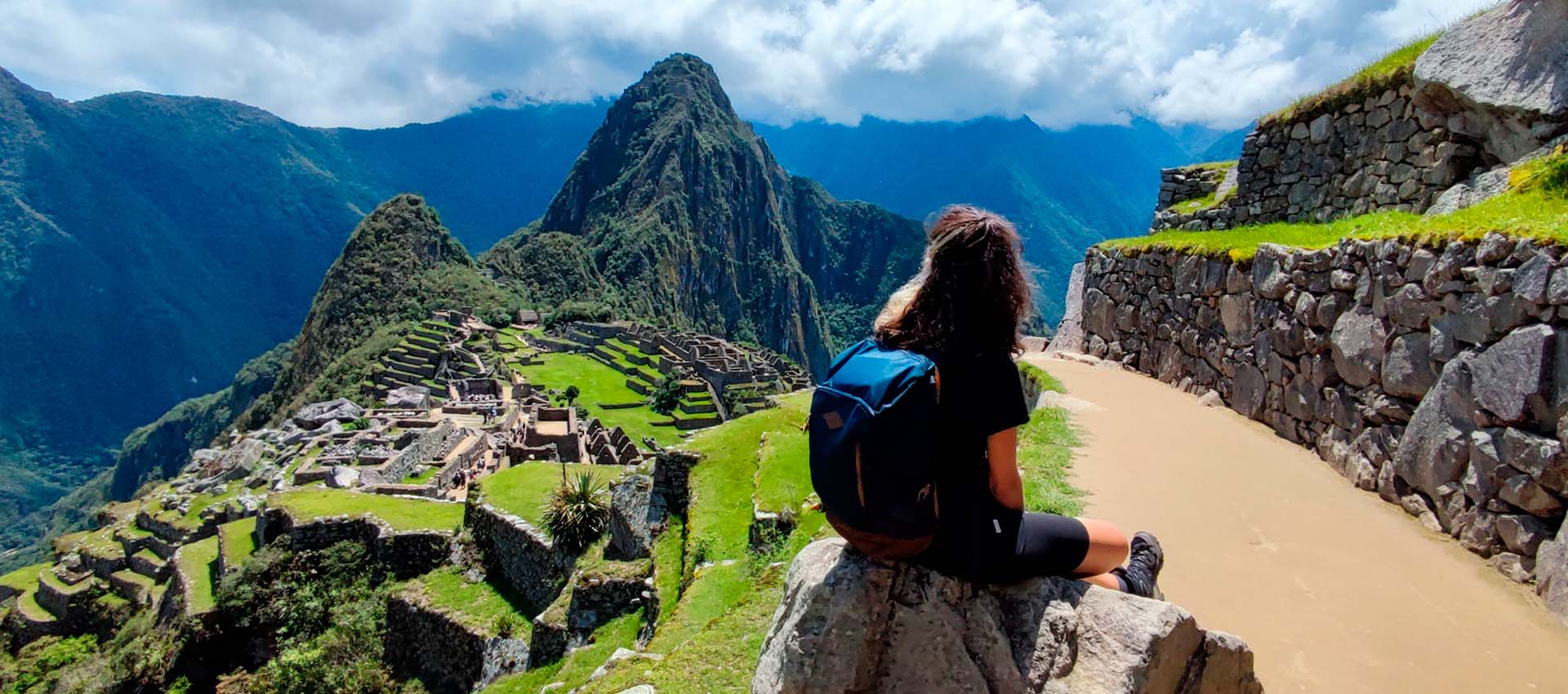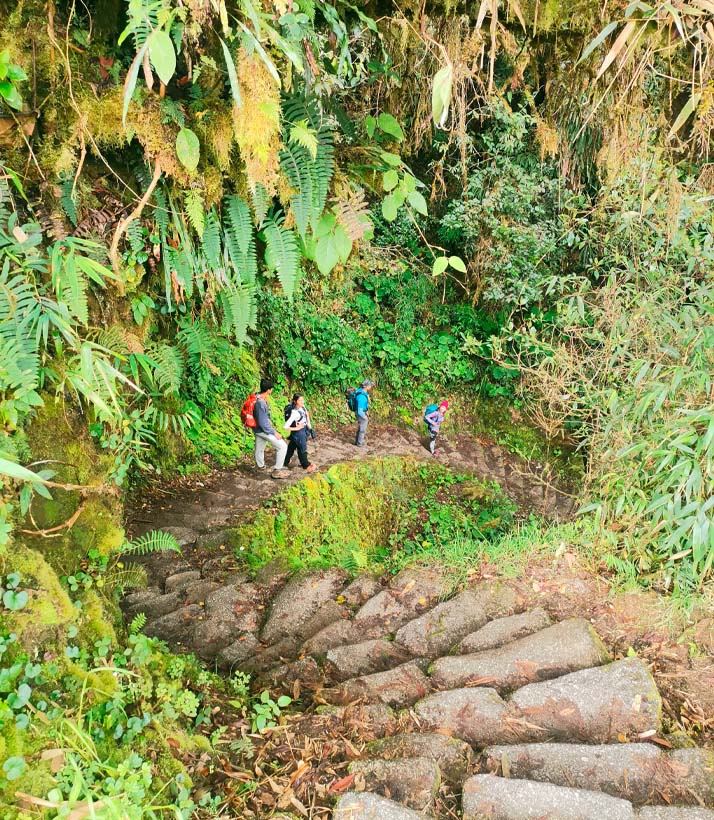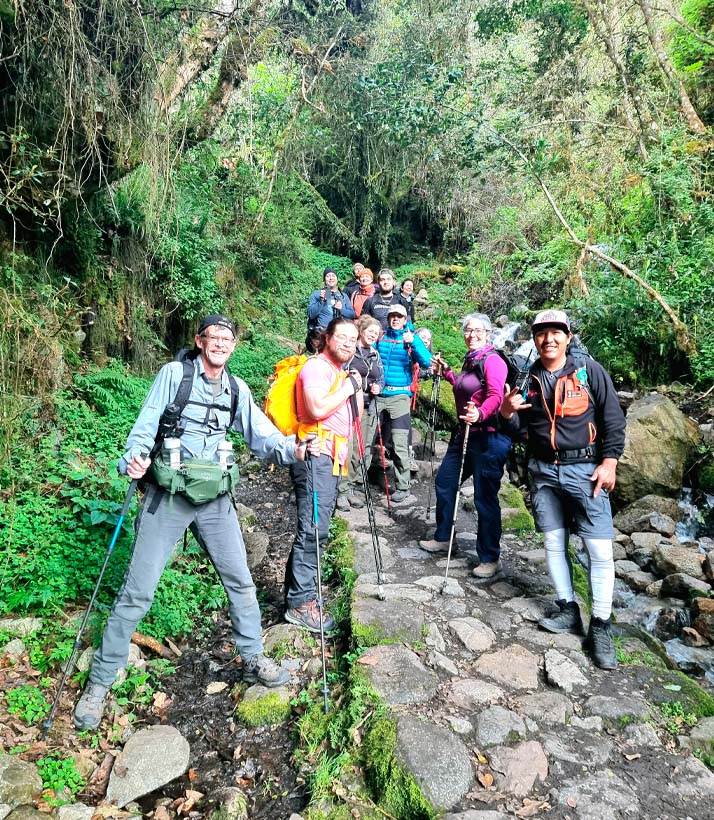
There’s a LOT of uphill and downhill on route to Machu Picchu. And often you are tackling very big steps. So here are five ways to train your legs and body for this reality so you can do the Inca Trail or Salkantay Trek comfortably and safely.
You want strong legs as well as good cardio, core muscles, flexibility and endurance to capably take on a Machu Picchu trek.
With that in mind, here are five key ways to train for a multiday trek to Machu Picchu.
Steps, steps, steps. One of the main features of both the Inca Trail (and its variations) and the Salkantay Trek is all of the stone steps. Steps up, and steps down. Big steps. Uneven steps. Seemingly endless steps at times.
And that’s not to mention other sections of the trails that have no steps, but still require you to tackle a challenging incline or decline.
So when it comes to training for the hike to Machu Picchu, a big focus should be step training. You want your leg muscles, tendons and reflexes to be well developed so that they can cope with the rigours of a few consecutive days of hard trekking.
One of the best ways to develop your legs in an even fashion is to walk or jog up and down the steps in a stadium or a high rise building. Doing this prepares your legs for the downhill as much as the uphill. It also develops your joints, tendons and so on in ways that you can’t get from squats and lunges, for instance.

On the Inca Trail, you are navigating stone steps that were created by the Incas half a millennium ago!
It’s likely, however, that you won’t be able to just do this sort of training. And only doing stairs could get boring. So let’s look at some further leg exercises that are great physical preparation for trekking to Machu Picchu …
You want to train your legs muscles, tendons and reflexes to cope well on a trek to Machu Picchu.
We recommend doing one or more of the following exercises to help develop your legs for the uphill:
Bench step ups are particularly useful as you will face many steps of a similar depth on the Inca Trail and Salkantay Trek. Some of the steps, by the way, are centuries old!
Of course you can also do exercises that focus on particular muscles. But just be sure to develop the different leg muscles evenly if you go this route.
Occasionally the steps on the Inca Trail are so big that trekkers use their hands to help them clamber up.
As discussed, one of the main features of any trek to Machu Picchu is the countless steps you must scale and descend. Yet sometimes folks come prepared for the uphill of a trek, but not so much the downhill.
Past Machu Picchu trekkers have noted that they were prepared for all the steps up, but not as much for the steps down.
Please note that you start and end your trek (whether the Inca Trail or Salkantay Trek) at similar elevations. So every step up must at some point be met with a step down. It’s therefore important that you train your legs. You especially want strong quads, lateral hip stabilisers and knee and ankle joints.
Some exercises that work well for preparing your legs for the downhill rigours of a Machu Picchu trek are:
Pistol squats are especially good for hip flexibility. And flexibility is a real bonus on any trek to Machu Picchu.
If you have weak knees, ankles or feet, be sure to focus on building up their strength and resilience.
You are going to want good balance in all those moments when you’re poised on one foot in the midst of a step up or down. While we highly recommend having trekking poles to assist you on the trek, you also want a strong core to help you here.
While full body workouts like those described above to strengthen your legs will also develop your abs when done right, we recommend also including some targeted core exercises in your physical training for your Machu Picchu trek.
Remember that your core is about more than just your abdominal muscles. You should also work on all of the other muscles surrounding your trunk, like your obliques and lower-back muscles.
Both the Salkantay Trek and Classic Inca Trail are traditionally 4 day treks.
So … can you hike for several hours and then do it again on three consecutive days? If not, you need to build up your endurance before heading off on a Machu Picchu trek.
To develop endurance and stamina, you want to challenge your heart and lungs. You can do this by gradually increasing the duration and intensity of your workouts. If you do interval workouts, try to gradually diminish the duration of your rest breaks.
Of course the best way to develop your hiking endurance is to do many long hikes, so let’s look at that now …
The single best way to prepare for a trek to Machu Picchu is to do training hikes. And since you are going to be doing the Machu Picchu trek with trekking poles (everyone uses them, and they are a real asset on a trek like this), do these training hikes with your trekking poles to get used to using them.
If you can do a 2 day trek over the weekend and still then feel fresh enough on Monday to tackle another day of trekking should you need, then you’re well on your way to be ready for a Machu Picchu Hike!

Whether doing a workout or a training hike, we recommend mimicking the conditions of a Machu Picchu trek as much as possible.
This means, first of all, wearing the backpack you’ll take with you. And you want to load it up to the same capacity it will be on the trek. As you’ll most likely only need to carry your items for the day (because most Machu Picchu trekkers give their porter the bulk of their belongings to transport), this means putting drinking water, some food, rain gear, a warm jacket and some gadgets like a camera) into your backpack.
You want to train with a loaded backpack not only because of the extra weight, but also to ensure the backpack you’ve chosen sits well and is truly comfortable under all sorts of conditions and when worn for a long time.
Another key item to wear when training – especially on training hikes – is your pair of trekking boots. As we discuss in your Packing list for trekking to Machu Picchu, it’s vitally important that you only come to Peru with a pair of properly worn-in boots.
You should also train in the socks that you’ll bring to Peru, as these also play a critical role in ensuring happy and healthy feet on the trek.
Besides your socks, boots and backpack, we recommend that at some point you also wear everything else you plan to use on the Machu Picchu trek. We’re talking about the underwear, trousers and shirts you’re going to bring. By training in all of your full clobber, you’ll know for sure that everything fits comfortably and works seamlessly together, even after hours of wear.
A final note …
Your training for Machu Picchu should ideally start a few months before your trip. We recommend giving yourself at least three months to train, unless you’re already very hiking fit.
We know, however, that it can sometimes be tough to sustain a long training programme. Enthusiasm and motivation can wane, and discipline slide.
Be strategic at the outset, and have a plan in place for when your motivation flags. There are various ways to do this, like organising some training hikes with those who’ll be trekking to Machu Picchu with you. Or plan little breaks, albeit for a day or a week, where you just do exercise that’s fun for you, and not about your goal.
Maybe also stick pictures of the trek around your home, or create future alerts on your phone or inside your paper diary to inspire you when you later ‘discover’ them.
The main point is to be creative about it all. Because long-term goals are much more regularly achieved when you balance motivation with discipline, finding the sweet spot where the two meet. When you do that, we’re confident you’ll be ready when the time comes to head to Peru and conquer your trek to Machu Picchu!